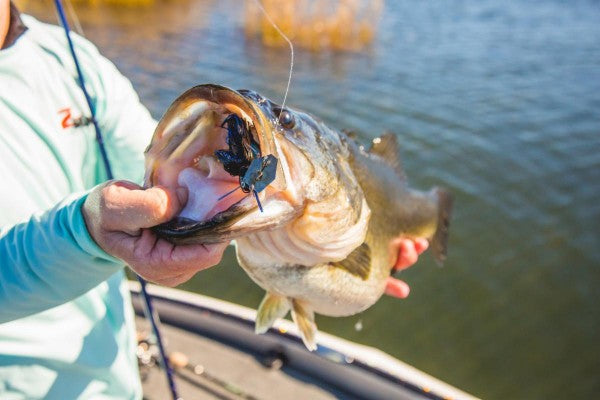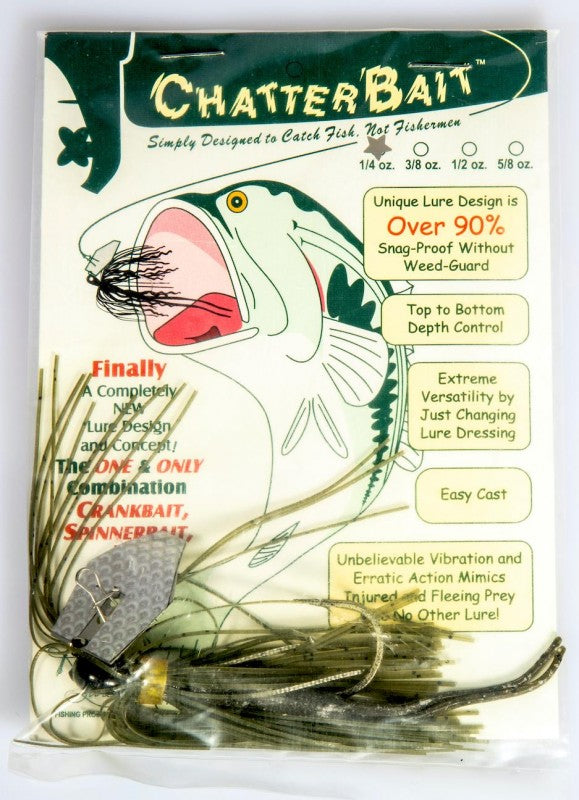
History of the ChatterBait


Chronicling the Original ChatterBait®
Why all bladed jigs aren't created equal
"If at first the new idea is not absurd, then there is no hope for it," claimed some chap named Einstein. Or, to paraphrase the dude who founded Amazon: Endeavoring to create something truly new implies a willingness to be misunderstood. Maybe automobile inventor Henry Ford said it best: "If I had asked the public what they wanted, they would have said a faster horse."
Proof the tackle architects at Z-Man® were on the right path arrived pretty much in synch with the 2022 ICAST New Product Showcase and the unveiling of their newest mind-bending creation.
Exhibit A: Z-Man's HellraiZer™ Tail Blade surface lure was met with equal parts awe and uncertainty—exactly the sort of reception you'd expect from a lure with so many . . . eccentricities. Comments ran the full spectrum, from 'It'll never work' and 'WTF?' to 'Looks like a topwater ChatterBait!' and 'Refreshing to see something this innovative from an American fishing company.'
Of course, the HellraiZer—which slinks across the surface with an inarguably unusual sound, vibration and action and which has begun to show signs of an authentic fish-catcher— did not win. In case you're keeping score, at their respective ICAST introductions, neither did the Original ChatterBait Bladed Jig nor the preeminent ChatterBait JackHammer™ to follow. (We'll humbly accept all the subsequent badges of honor.)
All of which aligns with the abovementioned notions of actual innovation; namely, that initial objections to a new, unfamiliar, radical idea only strengthen their ultimate status as groundbreaking, classic, and finally, undisputed category trendsetter.
Admittedly, the HellraiZer doesn't exactly resemble any other topwater lure released since 1937 (see Jitterbug.) But if you'll recall, neither did its bladed jig predecessors.

The Original Bladed Jig
Masterminded by the same man working in the same lure shop that hatched the HellraiZer, Ron Davis' Original ChatterBait once garnered disapproving glances and complete dismissals from every angler who saw it.
Imagine, then, standing in the shoes of Bryan Thrift—among the first professional anglers to tie on a ChatterBait, circa 2004. Picture yourself fishing the 2006 FLW tournament at Lake Okeechobee, making those first exploratory casts to giant Florida bass, 8- and 9-pound beasts that had never seen a ChatterBait in their lives. Looking back, no one is surprised by the ferocity with which those Okeechobee bass attacked Thrift's bladed jig, the lure that catapulted him to two straight major bass tournament wins. As word spread, the ChatterBait went from gimmick to overnight sensation—and soon, the basis for dozens of imitations thereof.
Listen to inventors Ron Davis and Ron Davis Sr. share the story of the Original ChatterBait.
"The difference between a Z-Man ChatterBait and every other bladed jig in existence lies in its high-level engineering and ultimately, its remarkable fishing success," admits Davis Sr., lifelong luresmith from Rock Hill, South Carolina. "From an angler's perspective, the disparities are easily measured by the lure's underwater performance. Or you might simply consider its countless tournament wins and the sheer number of big fish the ChatterBait continues to catch."
In the eyes of a lure designer, however, the distinctions reside in the details. "The ChatterBait emits a very specific vibration," notes Davis. "The lure produces its own underwater signature that closely replicates the tailbeats of fleeing preyfish. When you cast and retrieve it, the ChatterBait's powerful vibration provides constant feedback through the rod. It's almost hypnotic; certainly, it captivates fish."
For Davis, the lure's fish-catching genius relates specifically to the active mechanics at play between the blade and jighead, enhanced by the lure's silicone skirt and soft plastic trailer. "As you pull the lure through the water, the specific blade-to-jig linkage of a ChatterBait compels it to swim with a random right and left hunting action," observes Davis. "Combined with its precise vibration, the lure's unpredictable juking motions elicit intense predatory responses. Achieving this erratic lure action took decades of on-water observation and lure testing.
"All you have to do is fish it against any another bladed jig and the talents of a true ChatterBait come shining through," he believes. "Other bladed jigs simply don't deliver the same sound, action or extreme vibration. Quite simply, if it doesn't say ChatterBait on the blade, you might want to reconsider the lure you're about to cast."

Z-Man currently crafts 17 different ChatterBait Bladed Jig models.
High performance features like water-thumping pulsations, hunting action and snag-resistance all point directly to the ChatterBait's design. "The fine details are so critical to fishing performance and success that we went to great lengths and expense to patent the ChatterBait's design in the U.S.," notes Davis. "We knew we were in uncharted waters. In effect, we were establishing the foundations of a totally new lure category, with a very specific set of ingredients baked into its DNA. Change any of these specifications, and regardless of what you call the lure, your on-the-water success will be drastically diminished."
"A Different Way to Make a Lure Wiggle"
When Davis of Rock Hill, South Carolina invented the ChatterBait over two decades ago, he established an entirely unique lure category in the process. The ChatterBait's success was so dramatic that it prompted some anglers to inaccurately adopt the term as a universal catch-all encompassing all bladed jigs to follow.
Among these critical elements, Davis exhaustively tested various blades, jigheads and endless ways to connect the two—all in efforts to add high-level action and vibration to a larger-profile, weighted jig. Twenty years of experience in automobile R&D, working with steel strands and other high-tech fibers, taught Davis valuable lessons. "In product R&D, you learn from everything you do—there's no such thing as a mistake."
His original goal in designing the ChatterBait was to create "a different way to make a lure wiggle." To get there, Davis focused on the blade's units of movement versus units of pull on the lure. "One overlooked attribute of the ChatterBait is its high volume of pulses in a short amount of time (vibration frequency), relative to the angler's pull on the lure," he said.
Ultimately, Davis' fine-tuning produced a lure that starts vibrating instantly, provides tangible feedback through the line, and induces strikes without requiring any fancy retrieves. "Just reel it back, and when the blade stops thumping, set the hook."

The CrossEyeZ™ ChatterBait excels around heavy woodcover.
The Critical Connection
Interestingly, the ChatterBait name came about not while brainstorming on a whiteboard, but while fishing the lure and observing its action. "One day, I was out fishing with my son Ronny, and after retrieving the lure and feeling my casting arm continually buzz, I mentioned that it was enough to make my teeth chatter," he recalls. "We had a good laugh, but soon realized the phrase perfectly matched how the lure performed in the water."
Thrift and others discovered early that the key to the ChatterBait's big fish allure pointed directly to Davis' design. "The direct connection between the blade and the jig restricts and optimizes the blade's movement and vibration and provides a side-to-side stopping point—absolutely critical to the lure's success," notes Thrift.
"Unfortunately, many manufacturers have attempted to mimic the ChatterBait's action, simply by slapping any similar style blade onto the jig's eyelet. As anglers fishing these knock-off lures quickly realize, there's more going on with the design of an actual ChatterBait. Things like deflection points—how far the blade oscillates back and forth, how and where the blade collides with the head, and the precise position of the line tie. Get any of these angles wrong—even by fractions of an inch—and the lure won't perform as intended.
"But get it right, as Davis did, and you'll benefit from the ChatterBait's fish-centric sound and powerful vibration, which you feel up and down the rod," says Thrift. "Anglers appreciate the immediate feedback right back to their hands. When the blade stops thumping or changes its cadence, that's a signal to the angler. Could indicate a stem of clinging vegetation or often, that a fish has chomped down on the lure.

"The other key thing that happens with a ChatterBait is the sound the lure makes as the blade repeatedly collides with the head," Thrift adds. "This 'clacking' sound is totally unique to a ChatterBait, and many anglers believe it triggers a predatory response. After a while, you get a unique paint wear pattern on the jig's nose. That means the lure's working as intended, and it's only a matter of time before something big and mean is going to attack it.
"Remember, too, that each ChatterBait version, from the Original ChatterBait to the Project Z™ and Big Blade™ ChatterBait all produce slightly different actions and vibrations." (Z-Man offers 17 ChatterBait lure models today.)
Summarizes Thrift: "You can pretend and call the bladed jig you're casting a ChatterBait all you want. But if it lacks all the right ingredients of the original, invented by Ron Davis, you probably won't keep it tied to your line for very long."